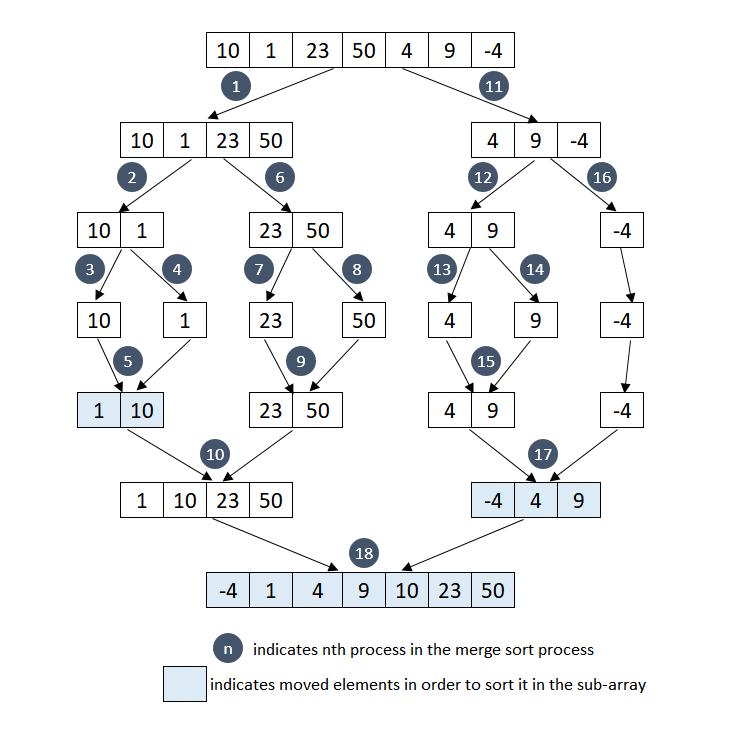C++ Program - Merge Sort
Merge sort is a divide and conquer algorithm. It is based on the idea of dividing the unsorted array into several sub-array until each sub-array consists of a single element and merging those sub-array in such a way that results into a sorted array. The process step of merge sort can be summarized as follows:
- Divide: Divide the unsorted array into several sub-array until each sub-array contains only single element.
- Merge: Merge the sub-arrays in such way that results into sorted array and merge until achieves the original array.
- Merging technique: the first element of the two sub-arrays is considered and compared. For ascending order sorting, the element with smaller value is taken from the sub-array and becomes a new element of the sorted array. This process is repeated until both sub-array are emptied and the merged array becomes sorted array.
Example:
To understand the merge sort, lets consider an unsorted array [4, 9, -4] (right side array created after 11th process in the below diagram) and discuss each step taken to sort the array in ascending order.
At the first step, the array [4, 9, -4] is divided into two sub-array. The first sub-array contains [4, 9] and second sub-array contains [-4]. As the number of element in the first sub-array is greater than one, it is further divided into sub-arrays consisting of elements [4] and [9] respectively. As the number of elements in all sub-arrays is one, hence the further dividing of the array can not be done.
In the merging process, The sub-arrays formed in the last step are combined together using the process mentioned above to form a sorted array. First, [4] and [9] sub-arrays are merged together to form a sorted sub-array [4, 9]. Then [4, 9] and [-4] sub-arrays are merged together to form final sorted array [-4, 4, 9]

Implementation of Merge Sort
#include <iostream>
using namespace std;
static void mergesort(int Array[], int left, int right);
static void merge(int Array[], int left, int mid, int right);
static void PrintArray(int Array[], int n);
// function for merge sort - splits the array
// and call merge function to sort and merge the array
// mergesort is a recursive function
static void mergesort(int Array[], int left, int right) {
if (left < right) {
int mid = left + (right - left)/2;
mergesort(Array, left, mid);
mergesort(Array, mid+1, right);
merge(Array, left, mid, right);
}
}
// merge function performs sort and merge operations
// for mergesort function
static void merge(int Array[], int left, int mid, int right) {
// Create two temporary array to hold split
// elements of main array
int n1 = mid - left + 1; //no of elements in LeftArray
int n2 = right - mid; //no of elements in RightArray
int LeftArray[n1], RightArray[n2];
for(int i=0; i < n1; i++) {
LeftArray[i] = Array[left + i];
}
for(int i=0; i < n2; i++) {
RightArray[i] = Array[mid + i + 1];
}
// In below section x, y and z represents index number
// of LeftArray, RightArray and Array respectively
int x=0, y=0, z=left;
while(x < n1 && y < n2) {
if(LeftArray[x] < RightArray[y]) {
Array[z] = LeftArray[x];
x++;
}
else {
Array[z] = RightArray[y];
y++;
}
z++;
}
// Copying the remaining elements of LeftArray
while(x < n1) {
Array[z] = LeftArray[x];
x++;
z++;
}
// Copying the remaining elements of RightArray
while(y < n2) {
Array[z] = RightArray[y];
y++;
z++;
}
}
// function to print array
static void PrintArray(int Array[], int n) {
for (int i=0; i<n; i++)
cout<<Array[i]<<" ";
cout<<"\n";
}
// test the code
int main (){
int MyArray[] = {10, 1, 23, 50, 4, 9, -4};
int n = sizeof(MyArray) / sizeof(MyArray[0]);
cout<<"Original Array\n";
PrintArray(MyArray, n);
mergesort(MyArray, 0, n-1);
cout<<"\nSorted Array\n";
PrintArray(MyArray, n);
return 0;
}
The above code will give the following output:
Original Array 10 1 23 50 4 9 -4 Sorted Array -4 1 4 9 10 23 50
Time Complexity:
In all cases (worst, average and best), merge sort always divides the array until all sub-arrays contains single element and takes linear time to merge those sub-arrays. Dividing process has time complexity Θ(logN) and merging process has time complexity Θ(N). Therefore, in all cases, the time complexity of merge sort is Θ(NlogN).
Recommended Pages
- C++ Program - To Check Prime Number
- C++ Program - Bubble Sort
- C++ Program - Selection Sort
- C++ Program - Maximum Subarray Sum
- C++ Program - Reverse digits of a given Integer
- C++ - Swap two numbers
- C++ Program - Fibonacci Sequence
- C++ Program - Insertion Sort
- C++ Program - Find Factorial of a Number
- C++ Program - Find HCF of Two Numbers
- C++ Program - To Check Whether a Number is Palindrome or Not
- C++ Program - To Check Whether a String is Palindrome or Not
- C++ Program - Heap Sort
- C++ Program - Quick Sort
- C++ - Swap Two Numbers without using Temporary Variable
- C++ Program - To Check Armstrong Number
- C++ Program - Counting Sort
- C++ Program - Radix Sort
- C++ Program - Find Largest Number among Three Numbers
- C++ Program - Print Floyd's Triangle


